Influence of Adhesive Bonding on the Dynamic and Static Strain Transfers of Fibre Optic Sensors
Abstract
:1. Introduction
2. Analytical Model
2.1. Implementation of the Analytical Model
- All materials are linear and elastic;
- There is no sliding at the interfaces, so the layers are perfectly bonded together;
- The host material, which in our case will be aluminium, experiences a uniform longitudinal strain;
- The core and cladding are considered as a single unit, as they share the same mechanical properties.
2.2. Influences of Parameters on the Strain Transfer
3. Materials and Method
3.1. Optical Fibres and Fibre Bragg Gratings (FBGs)
3.2. Optical Fibres Bonding
3.2.1. The Adhesives Used and the Bonding Protocol
- A coarse clean with a degreasing soap;
- Cleaning with an ethanol solution to remove ink marks and any other dirt;
- A large-area mild etching, using a phosphoric-acid solution;
- A local-area sanding step, to promote glue adherence;
- A large, and then localised and intensive cleaning, using the phosphoric-acid solution to remove metal residues caused by the sanding;
- A large, and then localised and intensive neutralisation, using an ammonia-based solution.
3.2.2. Bonding for FBG Measurements
3.2.3. Bonding for OFDR Measurements
3.3. Static Strain Experiment
3.4. Dynamic STRAIN Experiments
4. Results and Discussion
4.1. Static Strain Study on the Bonded FBGs
4.1.1. Experimental Results
- Firstly, the various adhesives transfer the deformation differently from the tensile specimen to the FBGs. As the bonding length has a huge influence on the strain transfer (Figure 2), and as this length is experimentally challenging to control, due to the various adhesive viscosities, the relative efficiency of the adhesive changes from one fibre to the other. This hypothesis will be verified via comparison with the analytical model in the next section.
- Secondly, we can see that the gratings written in the double acrylate-coated fibres are poorly sensitive to deformation in the aluminium sample. This is attributed to the high elasticity of these coating materials.
- Finally, we can state that bonded Bragg gratings inscribed on uncoated or polyimide-coated fibres are very sensitive to strain, and that uncoated gratings give similar or even better results than the strain gauges. For example, in Figure 7b, the FBG written on an uncoated fibre bonded with the NOA63 adhesive measured 176.5 ± 9.4 µ strain, as the strain gauge measured 167 µ strain, and the theoretical value obtained via Hooke’s law is 178 µ strain.
4.1.2. Comparison with the Analytical Model
4.2. OFDR Static Strain Study
Experimental Results
4.3. Dynamic Strain Experiences of the Bonded FBGs
5. Conclusions
Author Contributions
Funding
Institutional Review Board Statement
Informed Consent Statement
Data Availability Statement
Conflicts of Interest
References
- Bao, X.; Chen, L. Recent Progress in Distributed Fiber Optic Sensors. Sensors 2012, 12, 8601–8639. [Google Scholar] [CrossRef] [PubMed]
- Hartog, A.H. An Introduction to Distributed Optical Fibre Sensors; Series in Fiber Optic Sensors; CRC Press: Boca Raton, FL, USA; Taylor & Francis Group: Abingdon, UK, 2017; ISBN 978-1-4822-5957-5. [Google Scholar]
- Rao, Y.-J. Recent Progress in Fiber-Optic Extrinsic Fabry–Perot Interferometric Sensors. Opt. Fiber Technol. 2006, 12, 227–237. [Google Scholar] [CrossRef]
- Vengsarkar, A.M.; Lemaire, P.J.; Judkins, J.B.; Bhatia, V.; Erdogan, T.; Sipe, J.E. Long-Period Fiber Gratings as Band-Rejection Filters. J. Light. Technol. 1996, 14, 58–65. [Google Scholar] [CrossRef]
- James, S.W.; Tatam, R.P. Optical Fibre Long-Period Grating Sensors: Characteristics and Application. Meas. Sci. Technol. 2003, 14, R49–R61. [Google Scholar] [CrossRef]
- Ferdinand, P. Capteurs à fibres optiques à réseaux de Bragg. Mes. Mécaniques Dimens. 1999, 6735, 1–24. [Google Scholar] [CrossRef]
- Hill, K.O.; Meltz, G. Fiber Bragg Grating Technology Fundamentals and Overview. J. Light. Technol. 1997, 15, 1263–1276. [Google Scholar] [CrossRef]
- Kashyap, R. Fiber Bragg Gratings; Optics and Photonics; Academic Press: San Diego, CA, USA, 1999; ISBN 978-0-12-400560-0. [Google Scholar]
- Matveenko, V.P.; Shardakov, I.N.; Voronkov, A.A.; Kosheleva, N.A.; Lobanov, D.S.; Serovaev, G.S.; Spaskova, E.M.; Shipunov, G.S. Measurement of Strains by Optical Fiber Bragg Grating Sensors Embedded into Polymer Composite Material. Struct. Control Health Monit. 2018, 25, e2118. [Google Scholar] [CrossRef]
- Luyckx, G.; Voet, E.; Lammens, N.; Degrieck, J. Strain Measurements of Composite Laminates with Embedded Fibre Bragg Gratings: Criticism and Opportunities for Research. Sensors 2010, 11, 384–408. [Google Scholar] [CrossRef]
- Barrias, A.; Casas, J.R.; Villalba, S. Application Study of Embedded Rayleigh Based Distributed Optical Fiber Sensors in Concrete Beams. Procedia Eng. 2017, 199, 2014–2019. [Google Scholar] [CrossRef]
- Guo, Y.; Kong, J.; Liu, H.; Hu, D.; Qin, L. Design and Investigation of a Reusable Surface-Mounted Optical Fiber Bragg Grating Strain Sensor. IEEE Sens. J. 2016, 16, 8456–8462. [Google Scholar] [CrossRef]
- Cheng, Y.; Lu, X.; Gong, Y.; Wu, Y.; Rao, Y. Derrick Safety Monitoring System Based on Fiber Bragg Grating Strain Sensors. Photonic Sens. 2013, 3, 237–240. [Google Scholar] [CrossRef]
- Ansari, F.; Libo, Y. Mechanics of Bond and Interface Shear Transfer in Optical Fiber Sensors. J. Eng. Mech. 1998, 124, 385–394. [Google Scholar] [CrossRef]
- Liang, M.; Chen, N.; Fang, X.; Wu, G. Strain Transferring Mechanism Analysis of the Surface-Bonded FBG Sensor. Appl. Opt. 2018, 57, 5837. [Google Scholar] [CrossRef] [PubMed]
- Her, S.-C.; Huang, C.-Y. The Effects of Adhesive and Bonding Length on the Strain Transfer of Optical Fiber Sensors. Appl. Sci. 2016, 6, 13. [Google Scholar] [CrossRef]
- Wan, K.T.; Leung, C.K.Y.; Olson, N.G. Investigation of the Strain Transfer for Surface-Attached Optical Fiber Strain Sensors. Smart Mater. Struct. 2008, 17, 035037. [Google Scholar] [CrossRef]
- Floris, I.; Sangiorgio, V.; Adam, J.M.; Uva, G.; Rapido, M.; Calderón, P.A.; Madrigal, J. Effects of Bonding on the Performance of Optical Fiber Strain Sensors. Struct. Control Health Monit. 2021, 28, e2782. [Google Scholar] [CrossRef]
- Duck, G.; Renaud, G.; Measures, R. The Mechanical Load Transfer into a Distributed Optical Fiber Sensor Due to a Linear Strain Gradient: Embedded and Surface Bonded Cases. Smart Mater. Struct. 1999, 8, 175–181. [Google Scholar] [CrossRef]
- Shen, W.; Wang, X.; Xu, L.; Zhao, Y. Strain Transferring Mechanism Analysis of the Substrate-Bonded FBG Sensor. Optik 2018, 154, 441–452. [Google Scholar] [CrossRef]
- Li, W.Y.; Cheng, C.C.; Lo, Y.L. Investigation of Strain Transmission of Surface-Bonded FBGs Used as Strain Sensors. Sens. Actuators Phys. 2009, 149, 201–207. [Google Scholar] [CrossRef]
- Hejazi, F.; Chun, T.K. Advanced Solid Mechanics: Simplified Theory: Simplified Theory, 1st ed.; CRC Press: Boca Raton, FL, USA, 2021; ISBN 978-1-00-314682-7. [Google Scholar]
- Dillard, D.A. Fundamentals of Stress Transfer in Bonded Systems. In Adhesion Science and Engineering; Elsevier: Amsterdam, The Netherlands, 2002; pp. 1–44. ISBN 978-0-444-51140-9. [Google Scholar]
- Meidav, T. Viscoelastic Properties of the Standard Linear Solid. Geophys. Prospect. 1964, 12, 80–99. [Google Scholar] [CrossRef]
- Available online: https://www.exail.com/ (accessed on 11 July 2023).
- Girard, S.; Kuhnhenn, J.; Gusarov, A.; Brichard, B.; Van Uffelen, M.; Ouerdane, Y.; Boukenter, A.; Marcandella, C. Radiation Effects on Silica-Based Optical Fibers: Recent Advances and Future Challenges. IEEE Trans. Nucl. Sci. 2013, 60, 2015–2036. [Google Scholar] [CrossRef]
- Pillon, J.; Louf, F.; Boiron, H.; Rattier, M.; Peter, E.; Boucard, P.-A.; Lefèvre, H.C. Thermomechanical Analysis of the Effects of Homogeneous Thermal Field Induced in the Sensing Coil of a Fiber-Optic Gyroscope. Finite Elem. Anal. Des. 2022, 212, 103826. [Google Scholar] [CrossRef]
- Ismardi, A.; Sugandi, G.; Lizarna, M.A. Design and Simulation of Double Planar Spring Based on Polyimide for Electrodynamic Vibration Energy Harvesting. J. Phys. Conf. Ser. 2019, 1170, 012061. [Google Scholar] [CrossRef]
- HBM. Available online: https://www.hbm.com/fr/ (accessed on 11 July 2023).
- NOA. Available online: https://www.norlandprod.com/adhesiveindex2.html (accessed on 11 July 2023).
- Boiron, H.; Pillon, J.; Peter, E.; Robin, T.; Villedieu, T.; Morana, A.; Girard, S.; Boukenter, A.; Marin, E.; Lefèvre, H. Optical Fiber Strain and Temperature Coefficients Determination Based on Rayleigh-OFDR. In Optical Fiber Sensors Conference 2020 Special Edition; Optica Publishing Group: Washington, DC, USA, 2021; p. T3.42. [Google Scholar]
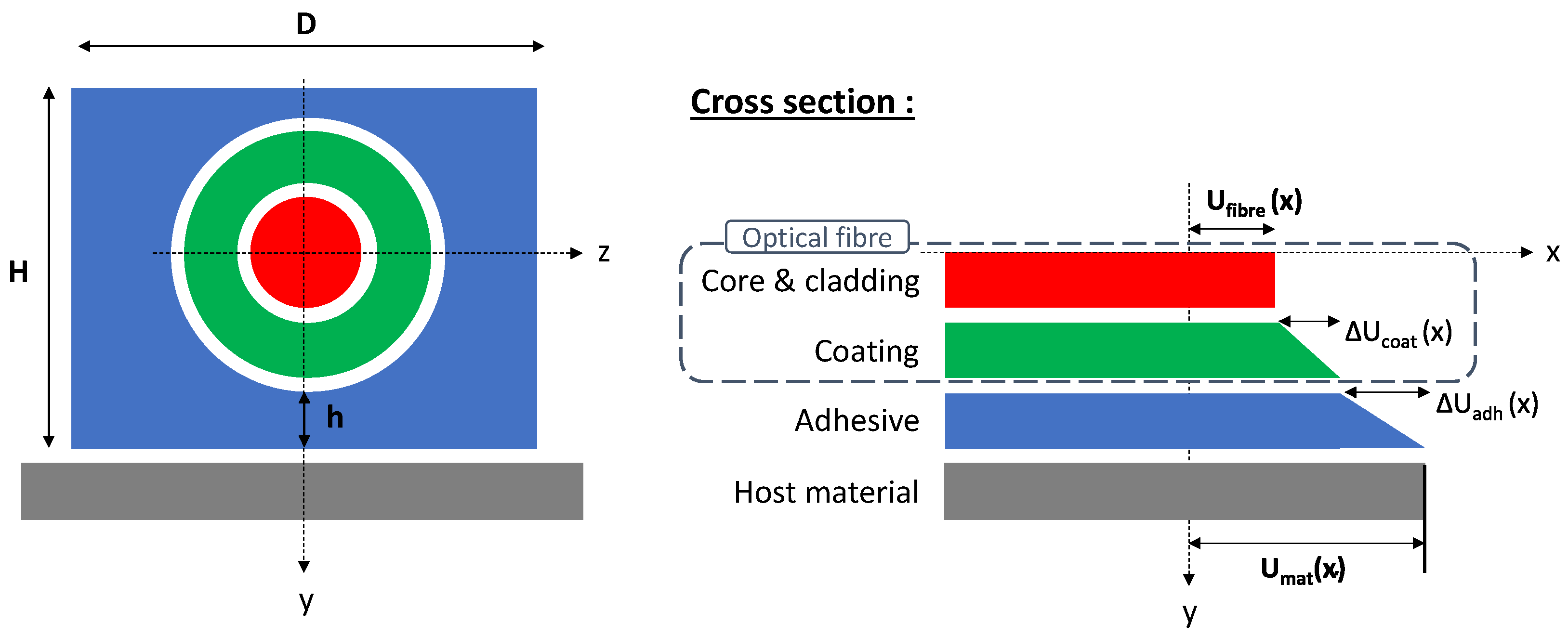
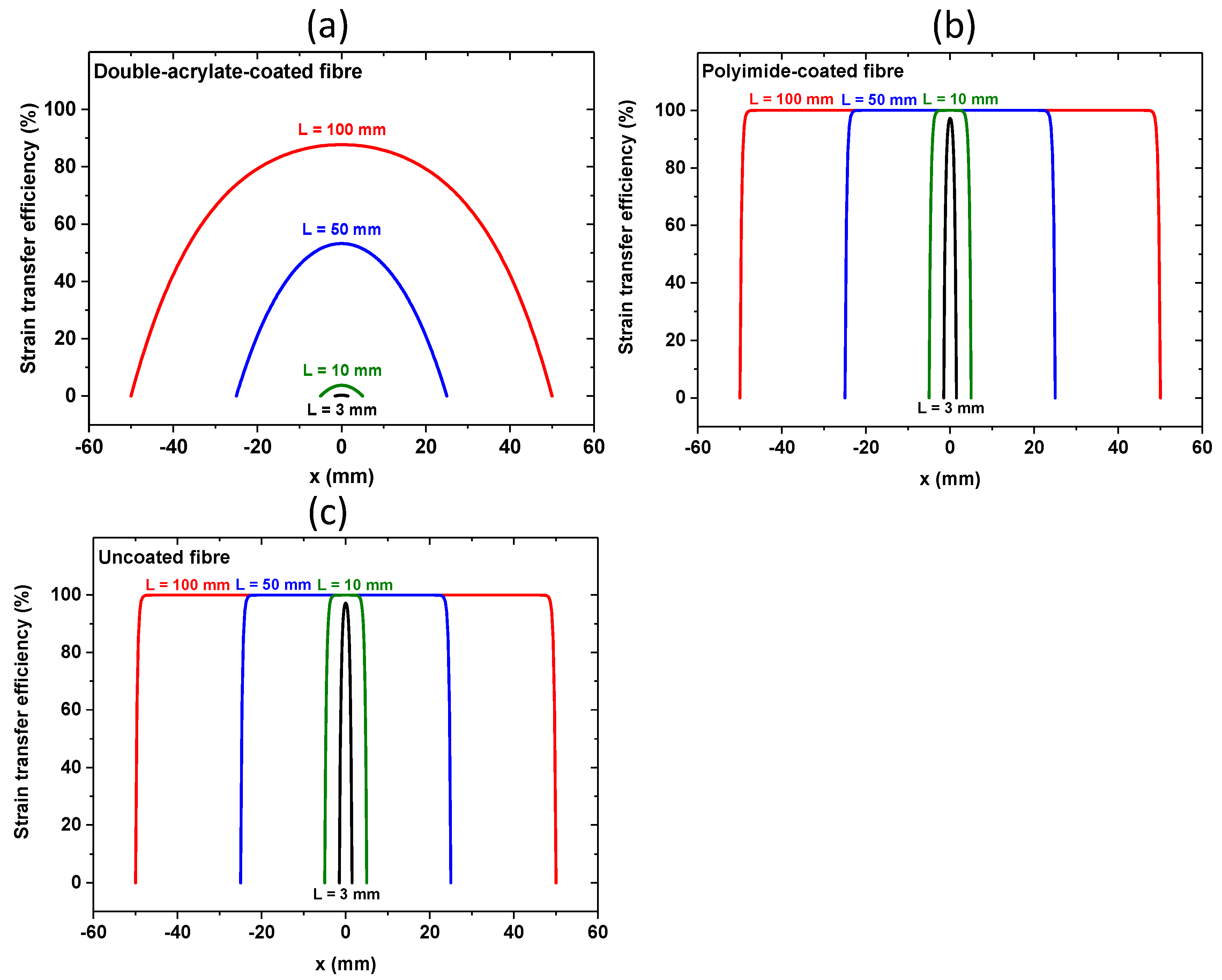

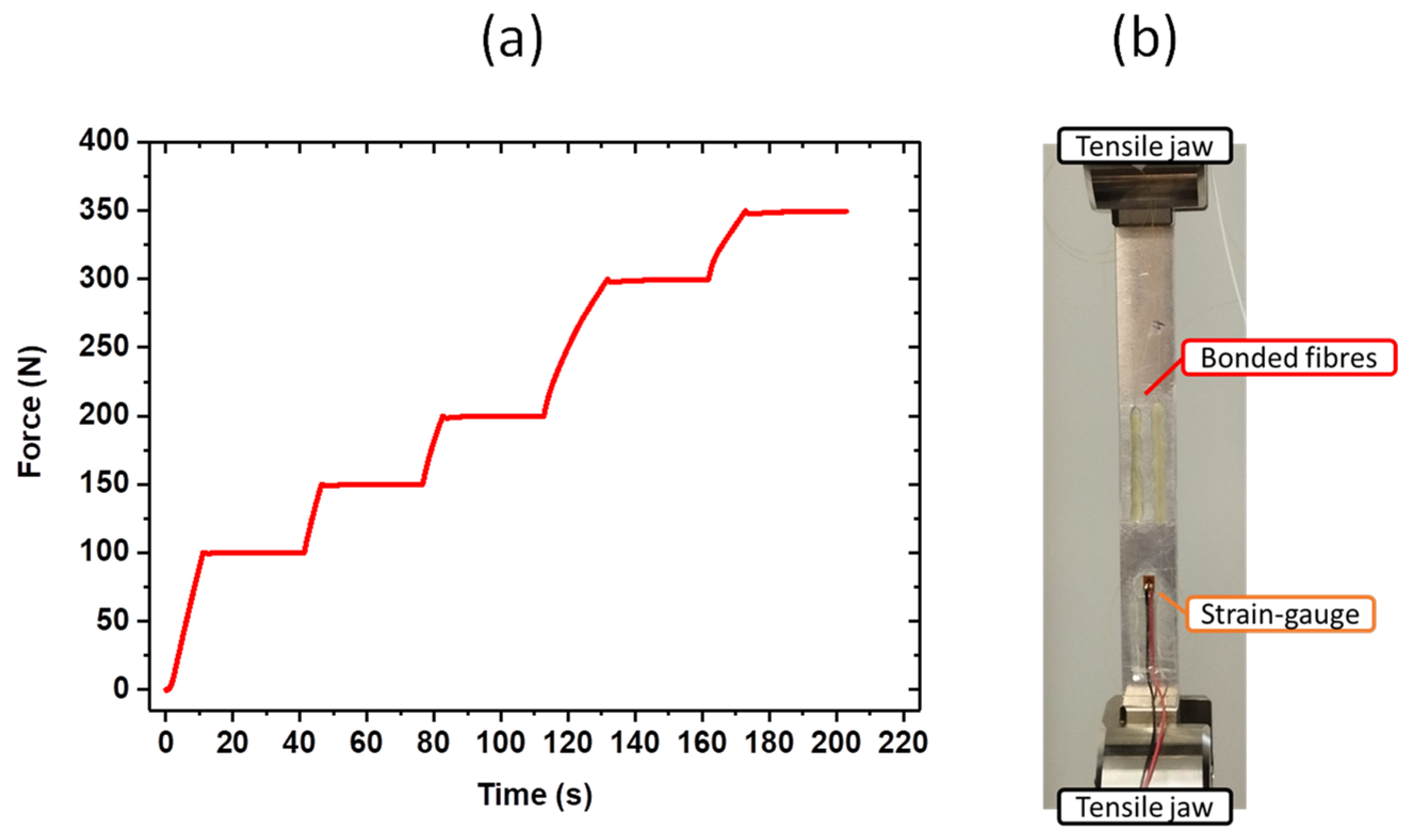
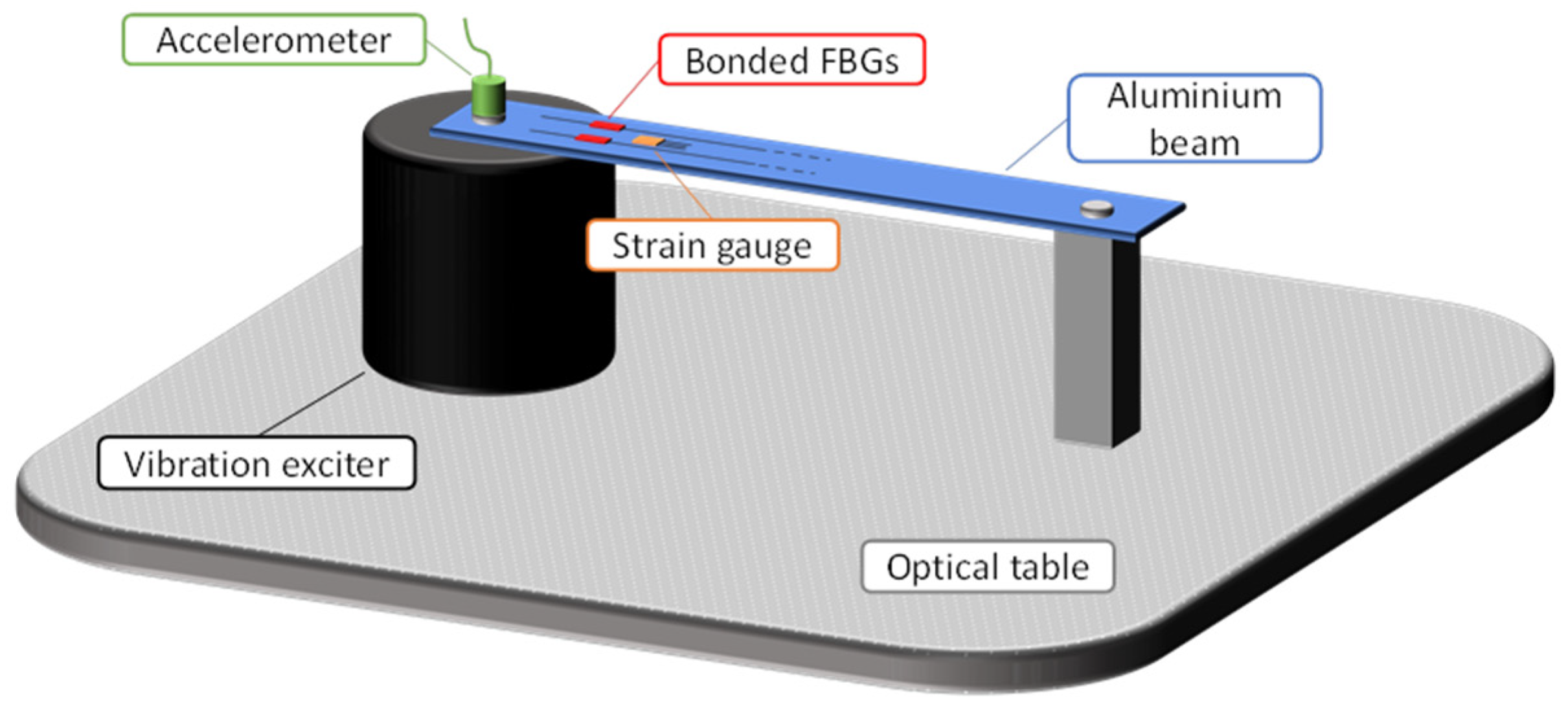
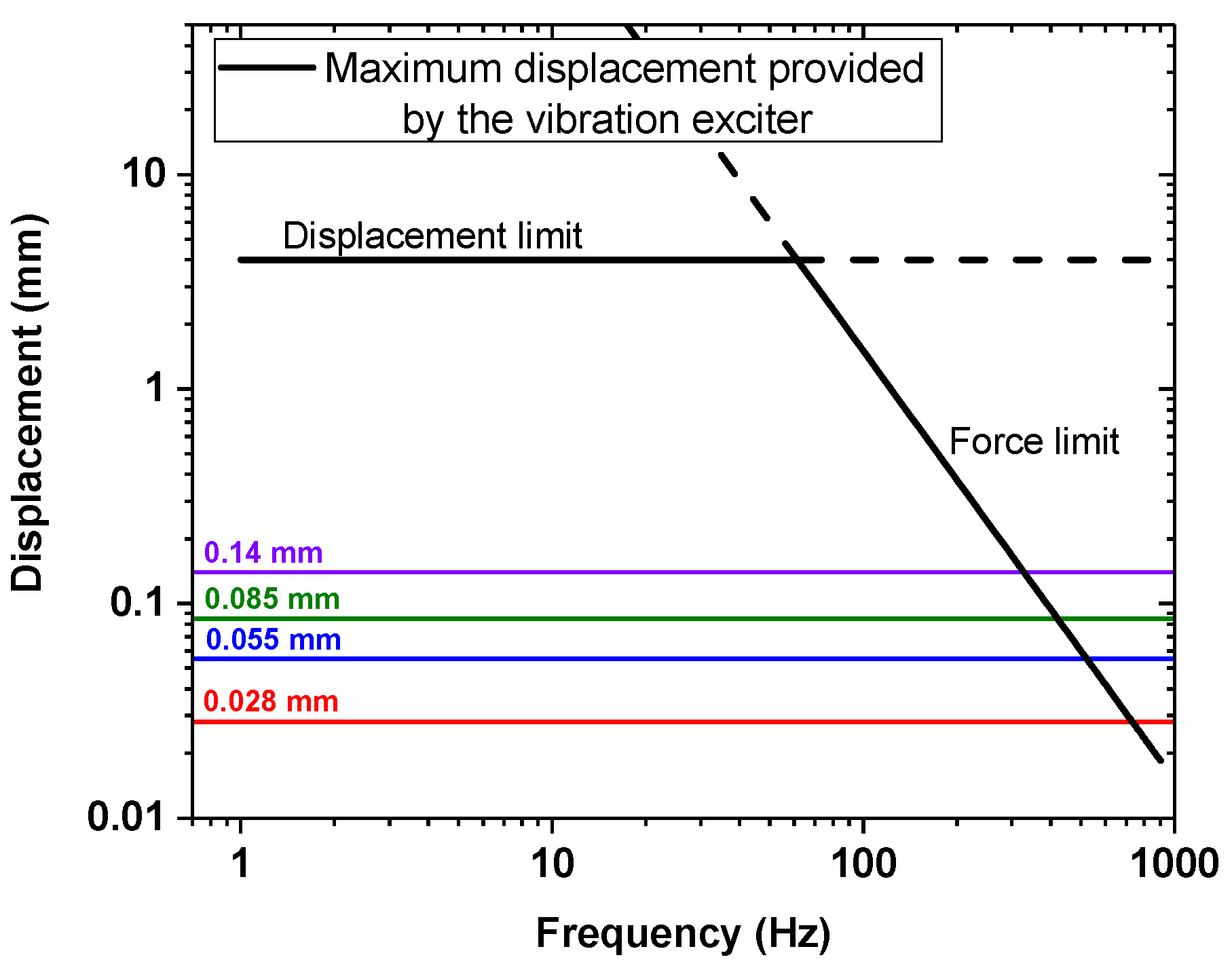

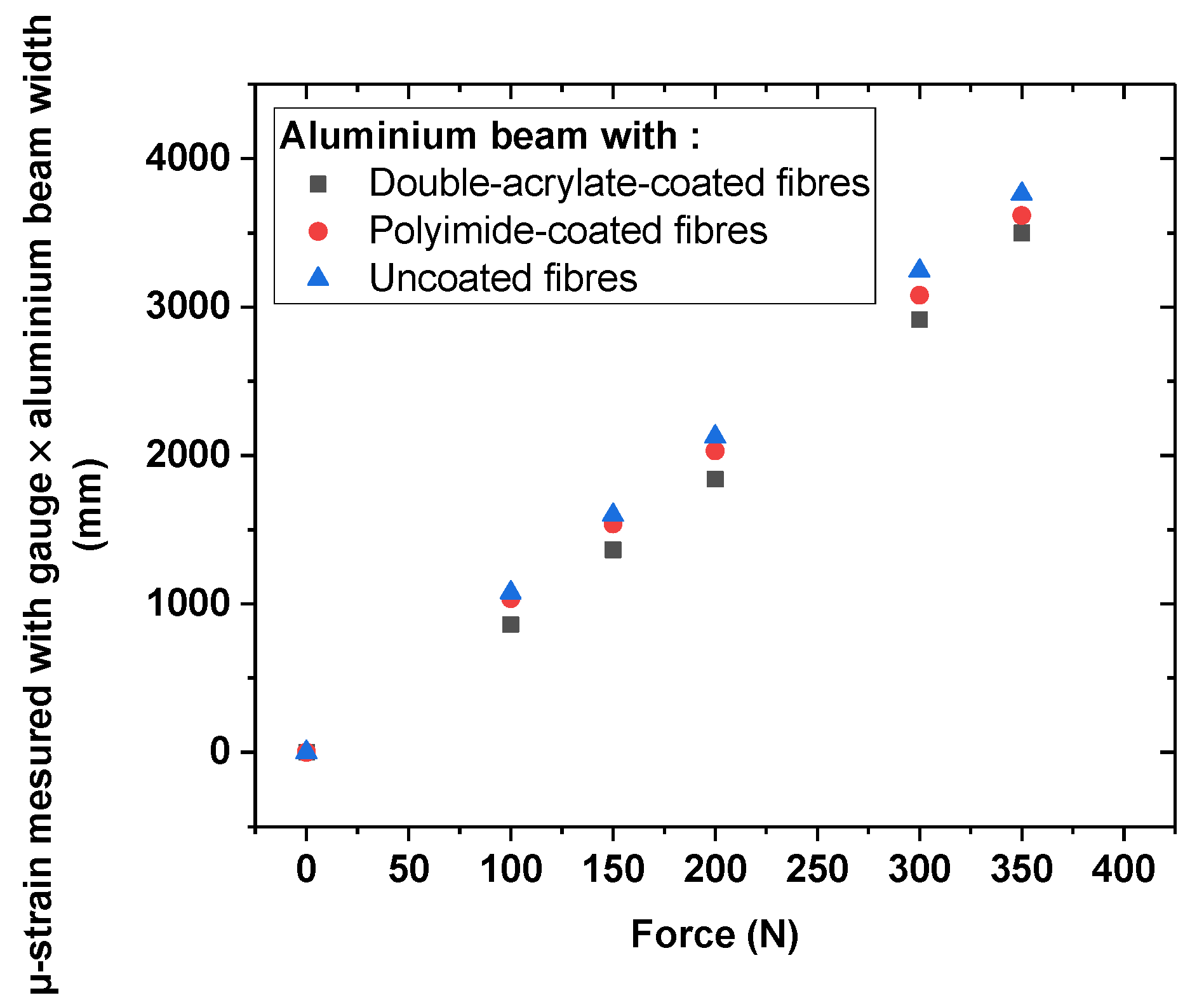

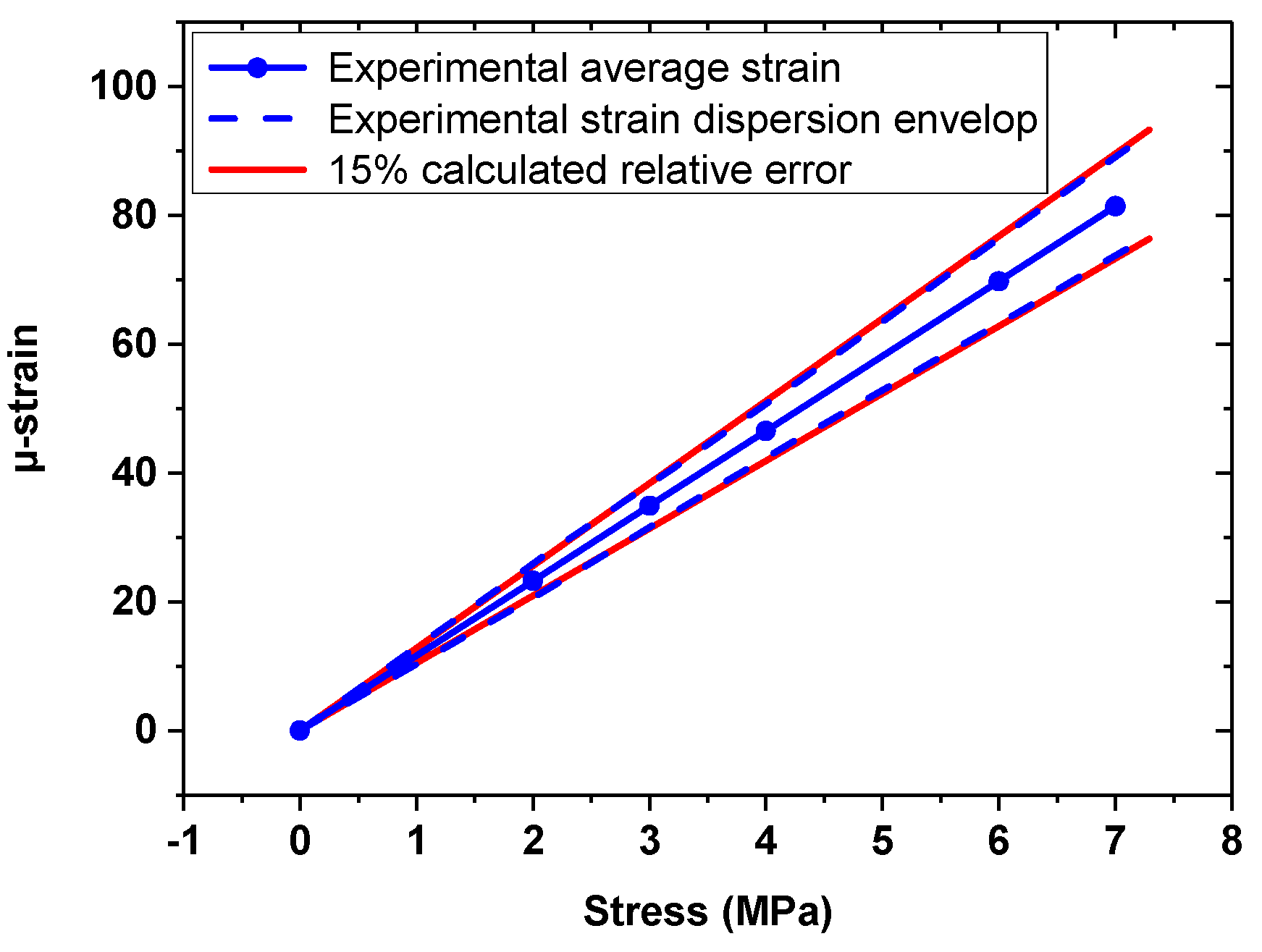
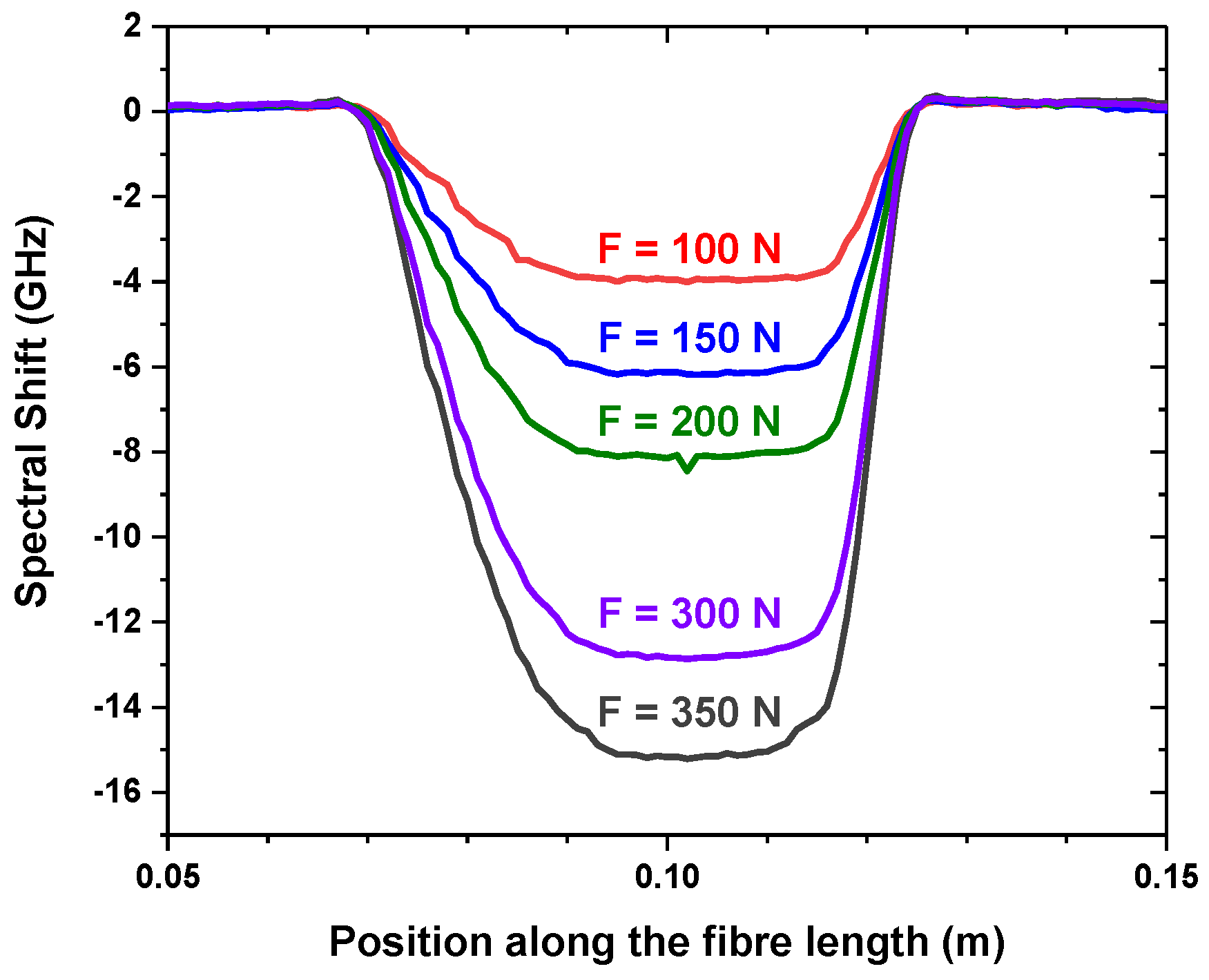

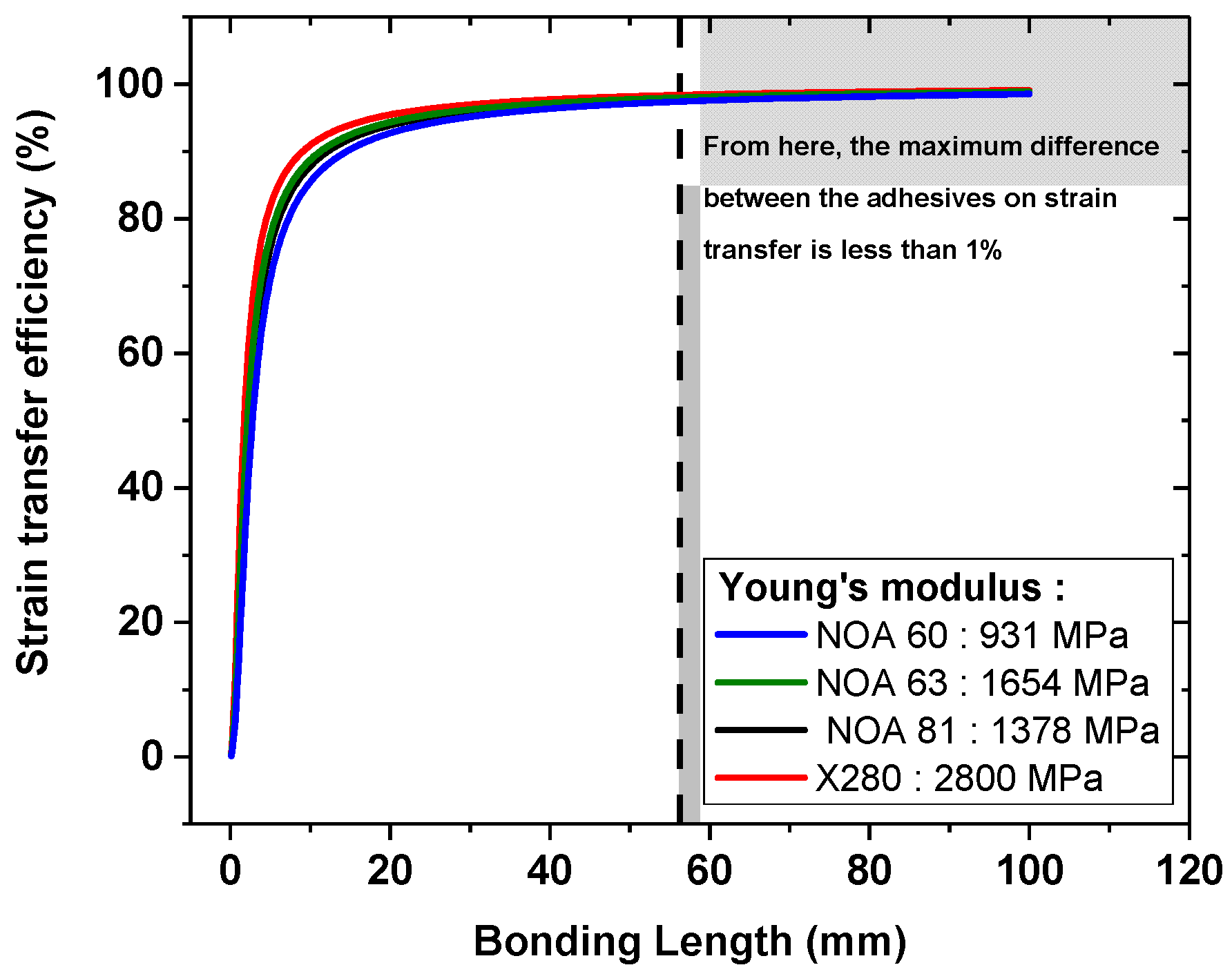
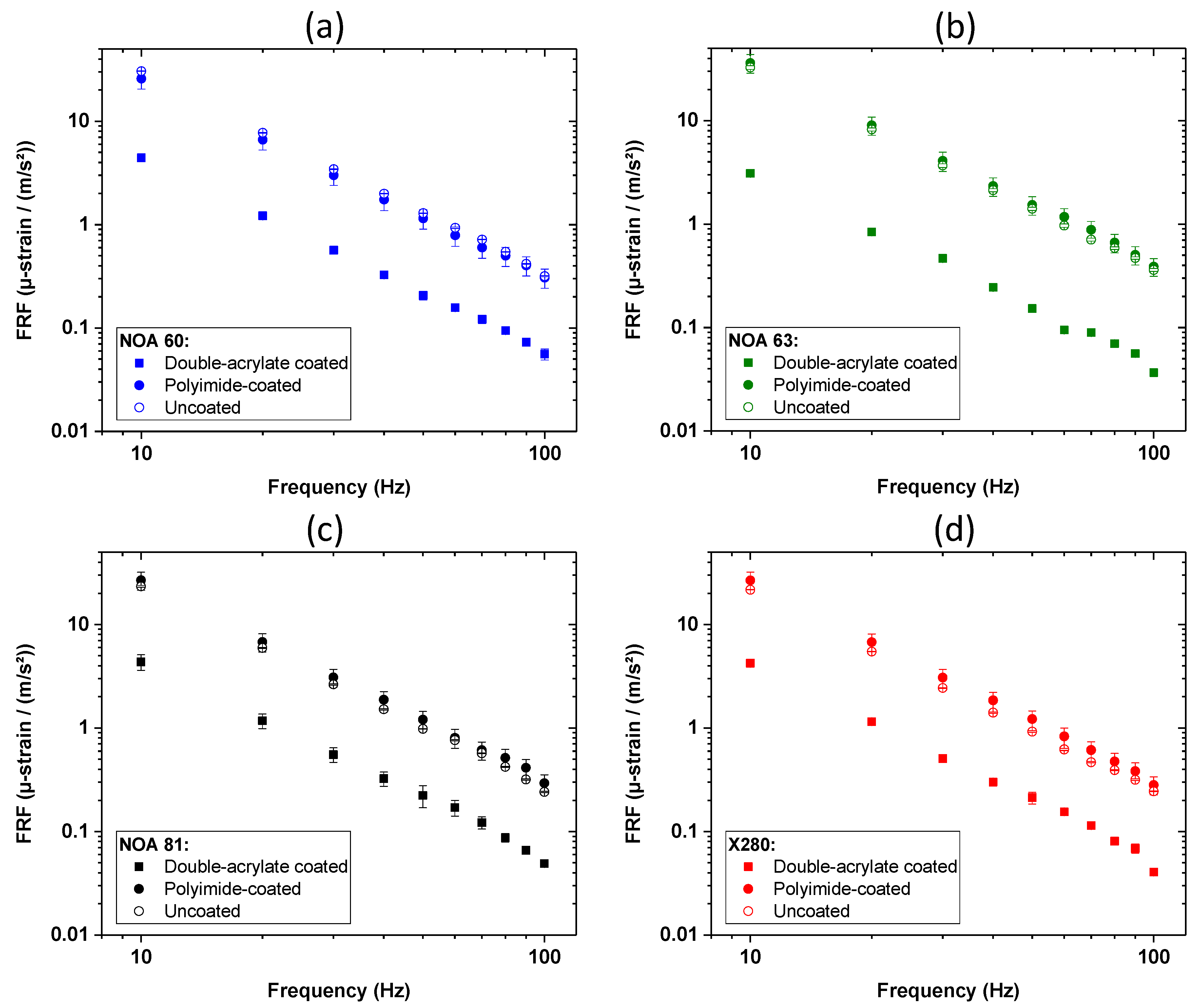
| Uncoated Fibre | Polyimide Fibre | Double-Acrylate Fibre | |
|---|---|---|---|
| Core + cladding | |||
| Radius (µm) | 62.6 | 62.35 | 62.6 |
| Young’s modulus (MPa) | 72,000 | 72,000 | 72,000 |
| Poisson ratio | 0.17 | 0.17 | 0.17 |
| First Coating | |||
| Radius (µm) | - | 79.4 | 95 |
| Young’s modulus (MPa) | - | 2500 | 4 (Ref. [17]) 1 (Ref. [27]) |
| Poisson ratio | 0.17 | 0.498 | |
| Second Coating | |||
| Radius (µm) | - | - | 122.5 |
| Young’s modulus (MPa) | - | - | 1000 (Ref. [17]) 1150 (Ref. [27]) |
| Poisson ratio | 0.368 | ||
| Adhesive | Intended for | Chemical Nature | Young’s Modulus (MPa) |
|---|---|---|---|
| X280 [29] | Gauge bonding | Epoxy | 2800 |
| NOA 63 [30] | Optic | Urethane | 1654 |
| NOA 81 [30] | Optic | Urethane | 1378 |
| NOA 60 [30] | Optic | Urethane | 931 |
| Aluminium Beam | Optical Fibre Coating | Adhesive | |
|---|---|---|---|
| Item | Dimension | ||
| 1 | 180 × 23.75 × 1.2 mm3 | Double-acrylate | NOA 81 |
| Double-acrylate | X280 | ||
| 2 | 180 × 23.75 × 1.2 mm3 | Double-acrylate | NOA 60 |
| Double-acrylate | NOA 63 | ||
| 3 | 180 × 23.75 × 1.2 mm3 | Polyimide | NOA 81 |
| Polyimide | X280 | ||
| 4 | 180 × 23.75 × 1.2 mm3 | Polyimide | NOA 60 |
| Polyimide | NOA 63 | ||
| 5 | 180 × 22.50 × 1.2 mm3 | Uncoated | NOA 81 |
| Uncoated | X280 | ||
| 6 | 180 × 22.50 × 1.2 mm3 | Uncoated | NOA 60 |
| Uncoated | NOA 63 | ||
Disclaimer/Publisher’s Note: The statements, opinions and data contained in all publications are solely those of the individual author(s) and contributor(s) and not of MDPI and/or the editor(s). MDPI and/or the editor(s) disclaim responsibility for any injury to people or property resulting from any ideas, methods, instructions or products referred to in the content. |
© 2023 by the authors. Licensee MDPI, Basel, Switzerland. This article is an open access article distributed under the terms and conditions of the Creative Commons Attribution (CC BY) license (https://creativecommons.org/licenses/by/4.0/).
Share and Cite
Landreau, C.; Morana, A.; Ponthus, N.; Le Gall, T.; Charvin, J.; Girard, S.; Marin, E. Influence of Adhesive Bonding on the Dynamic and Static Strain Transfers of Fibre Optic Sensors. Photonics 2023, 10, 996. https://doi.org/10.3390/photonics10090996
Landreau C, Morana A, Ponthus N, Le Gall T, Charvin J, Girard S, Marin E. Influence of Adhesive Bonding on the Dynamic and Static Strain Transfers of Fibre Optic Sensors. Photonics. 2023; 10(9):996. https://doi.org/10.3390/photonics10090996
Chicago/Turabian StyleLandreau, Chloé, Adriana Morana, Nicolas Ponthus, Thomas Le Gall, Jacques Charvin, Sylvain Girard, and Emmanuel Marin. 2023. "Influence of Adhesive Bonding on the Dynamic and Static Strain Transfers of Fibre Optic Sensors" Photonics 10, no. 9: 996. https://doi.org/10.3390/photonics10090996
APA StyleLandreau, C., Morana, A., Ponthus, N., Le Gall, T., Charvin, J., Girard, S., & Marin, E. (2023). Influence of Adhesive Bonding on the Dynamic and Static Strain Transfers of Fibre Optic Sensors. Photonics, 10(9), 996. https://doi.org/10.3390/photonics10090996






